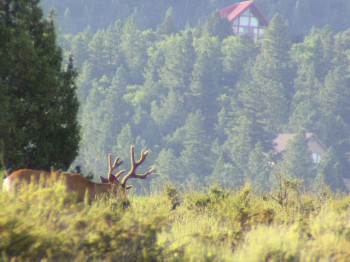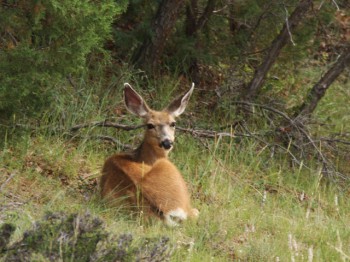by Todd A. Black
Jack H. Berryman a leader in wildlife management once said, “As the human population continues to grow and the competition for space and other resources increases, there will be more need for managing the damage caused by wildlife—the application of a wide variety of management, sociological, and economic tools to assure that wildlife resources remain an acceptable component of our national fabric.”
Urban wildlife
Urban and wildlife, some would argue that the two are an oxymoron. How can something that is wild also be urban? Urban areas by definition contain high densities of people. Today, most urban areas contain locally and unnaturally overabundant wildlife populations. With the creation of golf courses, landfills, agriculture areas, and back yard bird feeders, many populations of wildlife have reached artificially high numbers. It could be argued that very few species of wildlife don’t come into contact with man and his environment at least once in their life time. Certain avian and mammalian species have expanded their historical ranges and adapted rather well to this urban environment, while others have gone extinct or had their populations significantly reduced due to our increasing human populations and the demands this places on our natural resources.
 These ‘urbanized’ species of wildlife can sometimes create nuisance situations such as a pesky raccoon who tips over the garbage night after night. They may have an impact on human activities and livelihood like an irritated owl swooping down on passing bikers or an elk herd invading a farmer’s field. They can create perceived threats to human activities like the mountain lions that come out and prowl our cities by night, or create real threats to human health and safety such as deer vehicle collisions, Lyme disease and rabies. These wildlife conflicts affect someone everyday in a many different ways.
These ‘urbanized’ species of wildlife can sometimes create nuisance situations such as a pesky raccoon who tips over the garbage night after night. They may have an impact on human activities and livelihood like an irritated owl swooping down on passing bikers or an elk herd invading a farmer’s field. They can create perceived threats to human activities like the mountain lions that come out and prowl our cities by night, or create real threats to human health and safety such as deer vehicle collisions, Lyme disease and rabies. These wildlife conflicts affect someone everyday in a many different ways.
In many urban areas deer, birds, geese, mice and rats, and even some predators lessen the quality of life for many ‘urbanites’. It has been estimated that more than 70,000 human injuries, 400 fatalities, and over 3 billion dollars in economic losses occur annually due to human wildlife conflicts, the bulk of these occurring within the urban environment. The fact is our expanding population is increasing demands on our natural resources and the ever diminishing land base. This in turn increases the pressures and impacts placed on wildlife populations. Hence, the interests of man and the interests of wildlife often collide usually to the detriment of both but more often than not, our wildlife looses the battle.
In Utah, the species which has become the most well adapted to our urban setting, expanded and increased its range like no other, and causes most of the urban wildlife problems is the Raccoon(Procyon lotor). Interestingly enough the raccoon is not native to Utah and not protected by any wildlife laws and is now plentiful throughout the state. Raccoons to most people are pest plain and simple but there are those who think they are cute and cuddly and often keep them as pets. Studies conducted 10 years ago in Utah showed that 80% of the raccoons tested had been exposed to rabies. In addition to causing damage to gardens, fruit trees, and the chicken’s in farmer John’s chicken coop, raccoon’s feces quite often carry the roundworm egg which can be transferred to humans.
How do we deal with and manage urban wildlife?
Perhaps the biggest challenge to wildlife managers and state/federal wildlife agencies today is dealing with the urban wildlife interface. How we manage these species often results in conflicts with the public depending on our personal belief system and the interest we may have and how we view the welfare of individual animals. Most states have specific rules and regulations as to how they and the public can deal with ‘urbanized’ wildlife. These rules and regulations are driven by a myriad of issues but are often influenced by emotional and social issues rather than biology.
Most states discourage the feeding of wild animals and in some states feeding of big game animals is against the law. Yet millions of dollars are spent annually on bird feeders, bird seed, deer pellets, bird baths, squirrel house, bird houses and other wild animal attractants. A big question that has been asked by many researchers is what effect these artificially high or unnatural populations of wildlife are having not only on humans but other wildlife particularly those adjacent to the urban environment.
Feeding birds in the back yard has greatly increase local urban populations of the house finch. Other than building a nest in the occasional wrong place, the increasing house finch population seems to have little if any effect on other species and causes few human conflicts. Members of the corvid family (ravens, crows, and magpies) have also adapted well to the urban setting however, these species are adversely affecting many other species of wildlife that are found in and adjacent to the urban environment. Recent research has shown corvids to be having a significant impact on sage-grouse and other ground nesting bird eggs in upland environments adjacent to urban areas.
Management of urban wildlife is complex. No two individuals let alone species are the same and different management practices are employed for various species. In Utah for example, certain species (bear, mountain lions, and moose) are often tranquilized or trapped by state wildlife agencies and relocated outside the urban area. However, many of these individuals become habituated and often return causing further problems. More often than not, they usually end up being extirpated. Other big game such as deer and elk urban conflicts are dealt with through some means of hunting where specific animals or localized populations are targeted for removal through harvest where population numbers can be kept low or removed completely to further avoid human conflicts. Dealing with ‘pesky’ animal (starlings, skunks raccoons and squirrels) problems and issues are usually not even dealt with by state wildlife agencies but are left up to the homeowner to deal with individually or hire a private pest control business to remove or exterminate the problem animals. Quite often we create our own problems. We feed animals, provide habitat where animals can obtain shelter and cover or simply don’t maintain our homes and yards to avoid these conflicts.
What can we do?
 The demands for viable solutions to ‘urbanite’-wildlife conflicts are constantly increasing and we must expand our efforts, education, and means to deal with these issues. Solving these conflicts will continue to place a tremendous management challenge for state and federal wildlife biologist for the foreseeable future. Balancing the biological and social dimensions of urban wildlife issues will require capable, credible, and professional wildlife agency personnel. We need to be better educated in how to avoid and further urban wildlife conflicts. Most state agencies and Extension services provide educational material to help us better understand and deal with urban wildlife management conflicts and issues. Further, when dealing with these issues we as the public must realize the conflicts and see these problems and urban wildlife for what it really is. Not always are there going to be no simple solutions to this complex problem. Only by realizing the role we play and the importance of keeping these animals wild will we are able to fully understand and manage urban wildlife.
The demands for viable solutions to ‘urbanite’-wildlife conflicts are constantly increasing and we must expand our efforts, education, and means to deal with these issues. Solving these conflicts will continue to place a tremendous management challenge for state and federal wildlife biologist for the foreseeable future. Balancing the biological and social dimensions of urban wildlife issues will require capable, credible, and professional wildlife agency personnel. We need to be better educated in how to avoid and further urban wildlife conflicts. Most state agencies and Extension services provide educational material to help us better understand and deal with urban wildlife management conflicts and issues. Further, when dealing with these issues we as the public must realize the conflicts and see these problems and urban wildlife for what it really is. Not always are there going to be no simple solutions to this complex problem. Only by realizing the role we play and the importance of keeping these animals wild will we are able to fully understand and manage urban wildlife.



Good relevant article regarding wildlife issues. Although It is missing a reference to the known and personally experienced “Urban” coyote issue, about the fact that human encounters are on the rise not just on the prairie.